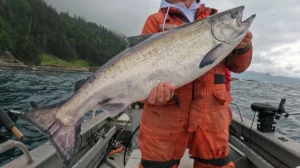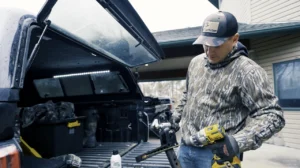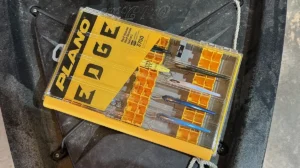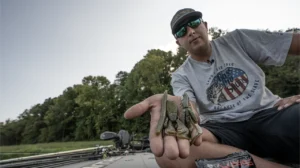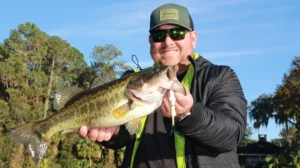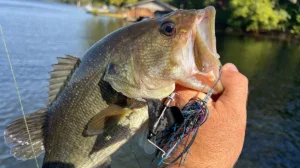When it comes to bass boats, the future has arrived. Fifty years ago, no one could have envisioned where these specialized boats with their sleek designs, high-powered motors and sophisticated electronics would be today.
“It was like when the Epcot Center at Disney World showed all these wild vehicles of the future,” said bass fishing legend Jimmy Houston, “We just couldn’t imagine a day when that would happen. Well, it’s the same way with bass boats. Except, it’s happening now.”
It’s particularly amazing for anglers of Houston’s era to see how far bass boats have come. Now 80 years old, Houston remembers customizing his first bass boat; he had a 14-foot Lonestar aluminum boat with a 20-horsepower outboard motor that he turned into a bass fishing machine.
First, he put a block of wood in the bow of the boat and attached a Silver Troll trolling motor to it. Then he wedged a board across the front of the boat so that he would have a platform to cast from. Nothing fancy. And nothing expensive either. That boat and its components didn’t cost much more than $1,000, he said.

Now? Fishermen are dropping close to $100,000 for a fully tricked out bass boat.
“For the cost of a bass boat and a tow vehicle today, you could have bought a house back in the day,” said Bob Cobb, former editor and writer for Bassmaster Magazine, who played a vital role in helping Ray Scott establish B.A.S.S.
It’s been a wild ride — from humble beginnings to modern technology, bass boats have come quite a way.
The Pioneers – The Skeeter and the Rebel Fastback Bass Boats
Holmes Thurmond was a visionary. An avid bass fisherman in the 1940s, he saw that the flat-bottom johnboats everyone used were hard to maneuver in the bayous and flooded timber near his home in Shreveport, Louisiana. So, the Evinrude Motor dealer set out to design a fast, stable boat that could be used to get in and out of the tight backcountry waters.
Enter what is recognized as the first true bass boat: the Skeeter.

Named as such because of its sharp nose that resembles that of a mosquito, the 13-foot wooden, flat-bottom boat was light and got on plane easily with the 5.4-horsepower Evinrude Zephyr motor it was paired with.
It had none of the bells and whistles of modern bass boats, but it was a means of staying mobile and squeezing into narrow openings, and that led to its early popularity.
That was just the start. Other companies came out and fed anglers’ need for speed and mobility. One of them was Plastics Research out of Fort Smith, Arkansas, which made a boat called the Rebel Fastback.
Now better-known for the plastic lures it made, (including Rebel crankbaits), Rebel built a boat that included two casting platforms, a 90-horsepower inboard-outboard Mercruiser motor, and a trolling motor.

Rebel was the boat sponsor for the first Bassmaster Classic in 1971, and the company provided identical boats for the competing fishermen. The Fastback models retailed for $4,000 at the time, and Rebel hoped to gain national exposure by providing the boats.
It was an intriguing idea — trying to level the playing field, but it didn’t last long.
“Fishermen had a hard time getting it up on plane, and it just didn’t perform that well,” said Bob Cobb, longtime editor of Bassmaster Magazine, who played a vital part in helping Ray Scott establish B.A.S.S. “We knew that wasn’t going to be a long-term answer.”
The Ranger Years
When Forrest Wood introduced his Ranger bass boats to Scott and some of the top pros, the timing couldn’t have been better.
Wood was a longtime float-fishing guide on the White River, but he saw the need for a reliable big-water boat. So, he began experimenting with the process of covering wooden boats with fiberglass.
By 1968, Forrest and his wife Nina went into business and founded Ranger boats, a name they chose because it represented a position of power (like the U.S. Army Rangers).
The Woods took pride in the fact that each boat was custom made to the customer’s specifications, but there was a limit to those alterations.

Basil Bacon, a member of the Bass Fishing Hall of Fame, remembers going to Wood and asking for a wider casting deck on the bow of a Ranger boat so that he could pursue a new tactic — flipping — that he had learned from West Coast fishermen.
Wood politely refrained, so Bacon built a crude casting deck himself, and proceeded to set an industry standard that many companies, Ranger included, eventually followed.
“You need room when you are flipping (an underhanded, pendulum-type cast) and the original bass boats didn’t have it,” Bacon said. “So, I just built one by myself, and for a while I did well in tournaments before others caught on to what I was doing.”
Wood and his crew built their first Rangers in Flippin, Arkansas, in a former dance hall at the edge of town. They sold their first boats for $4,000 each, and demand was high.
In the spring of 1971, a fire destroyed the factory and nearly put Ranger out of business. Wood and his crew were gearing up to provide the boats for Scott’s Bassmaster Classic, but that went up in smoke.
Wood was able to get into his business office and get his file that included his orders and he vowed to go on. He contacted the telephone company and got a new line and conducted his business outside for a while, from a simple telephone nailed to a tree.
The factory was quickly rebuilt, and the Woods continued manufacturing boats within a month and a half of the fire. It wasn’t long before Rangers were considered the gold standard of bass boats.
“Ranger changed the whole dimension of the sport,” Cobb said. “The pros weren’t confined to fishing a small area. They could run and gun, even on large lakes.”

Ranger: A Bass Boat Industry Leader
Houston, known for his blonde mop-top hair, his giggle, and his infectious enthusiasm for fishing, was one of the first to benefit.
He bought a 1969 Ranger in the fall of 1968. He also purchased a 100-horsepower Mercury motor, and he had the freedom to fish anywhere he wanted in tournaments on large bodies of water. And in relative comfort.
In the early days, most of the boats that anglers used to pursue bass were heavy, narrow and flat-bottomed –not exactly built for speed or comfort.
But Ranger came up with a design that combined a V-shaped hull with a wider beam to allow for more room to fish and a smoother ride.

“A beam of 60 inches might sound like a narrow boat, but we had a casting deck that allowed Chris (Houston’s wife who was also a professional angler) to be able to fish with me from the font,” Houston said. “In those early days, I could walk around on the rails of the boat to fish.
“I fell in quite a bit, but that was no big deal. The big thing about those first Ranger boats was the speed. We could eat up some of the lakes that were new at the time. It wasn’t anything for us to go 50 miles “
Ranger also set the pace in the industry by providing aerated live wells in the boats to keep bass alive during tournaments and by integrating flotation material that met U.S. Coast Guard safety standards.
Though Forrest and Nina Wood have both passed away, their legacy still lives on. While Ranger has undergone several ownership changes over the years, it remains one of the leaders in the bass boat game.
The Competition – Bass Cat and BPS
As B.A.S.S. and Ranger popularized the sport of competitive bass fishing, other companies got in on the game.

Bass Cat introduced its first bass boat in 1971 and quickly developed a following. Other companies such as Nitro, Tracker, Triton, Stratos, Phoenix, Champion, Lowe, and Xpress later got into the game, challenging Ranger and Skeeter for attention and anglers’ dollars.
In the late 1970s, Bass Pro Shops made a splash in the market when it introduced Tracker aluminum bass boats, which were sold at a more affordable price, appealing to a wider market.
By the 1990s, Bass Pro went one step further, introducing its first fiberglass bass boats under the Nitro name.
BP continued its investment in the bass boat game in December 2014, when it purchased Ranger, Stratos, and Triton. In the process, Johnny Morris’ White River Marine Group made a move to dominate the bass-boat industry.
But as with any other industry, there are winners and there are losers. Once popular bass boat brands like Champion, Stratos, Legend, and Gambler have all been discontinued.
Legends of the Bass Boat Game
Earl Bentz was a world-champion boat racer who turned to bass-boat design after leaving the fast lane.
He was a pioneer in early design, leaving his imprint on several companies. He got his start in 1975 when he joined the Hydra-Sports Boat Co. to design boats and help with research and development. He resigned in 1983 to form his own company, Stratos.
Bentz led Stratos to a leading role in fiberglass bass boat manufacturing, and soon developed a national following among bass anglers. His boats were known for speed, stability and safety.
He later sold his company, but was back in the national spotlight in 1996 when he and several partners founded Triton Boats.
More success followed, and more changes. Bentz founded Caymas Boats in 2018, and the company’s CX bass boats already have a following.
Randy Hopper is another icon of the bass-boat design game. He started working for Ranger as a teenager as part of the cleanup crew, and worked his way up to being the CEO and president of the company and Wood’s right-hand man.
Hopper played an integral part in designing the original Ranger bass boats, putting anglers’ wishes into reality. He developed ground-breaking techniques with fiberglass that still reverberate through the industry.
“We just took some simple ideas and incorporated them into a highly specialized fishing machine,” Hopper said in an article on Major League Fishing’s website (majorleaguefishing.com). “People liked what they saw and wanted the boats. People lined up for the boats because they were getting something very functional for them, giving them value.”
Hopper and several other longtime employees resigned from Ranger in 2015, about a year after Bass Pro Shops purchased the company. But he wasn’t done.
Hopper and several of those former Ranger workers went to work for Vexus Boats in 2017, returning to their roots in Flippin, Arkansas, to build a state-of-the-art production facility. They devoted themselves to making high-end fiberglass and aluminum bass boats, with Hopper as the CEO and guiding force.
Vexus remains in business today and the company is expanding as the market demands.
They’ve come a long way, baby
Shaw Grigsby, a longtime professional bass fisherman, is one of many who is amazed at how far bass boats have come.
“The early boats were boxy and some of them even had stick steering,” the Hall of Famer from Florida said. “A 125-horsepower motor was considered huge.
“We didn’t have all the electronics we have today. We had a flasher unit and that was about it. Look how far we’ve come.”
Grigsby runs a fully tricked-out Triton these days, with all the bells and whistles a bass fisherman could imagine.
Houston is the same way. He is proud of the fact that he has remained with Ranger since buying that first boat in 1968.
“I remember when Lowrance came out with their Little Green Box (flasher unit that showed depth and fish),” he said. “I told my dad, ‘I’ll catch every fish in the lake now.’
“Now, we have LiveScope and we still can’t catch them at times. We can look at them, but sometimes they just won’t bite. So, I guess even though we’ve seen so many changes, the fish are still in charge. We still have to work to figure them out, and that’s what makes it fun.”




![[VIDEO] How to Install the Garmin Force Pro Trolling Motor](https://www.wired2fish.com/wp-content/uploads/2025/06/trolling-motor-install-300x169.webp)

